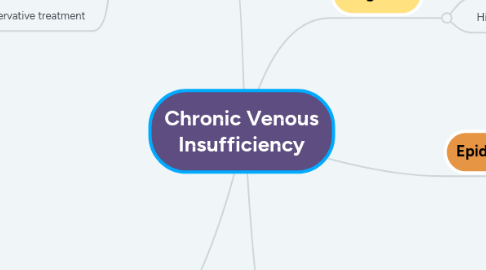Chronic Venous Insufficiency
by Wendy Coolman


1. Treatment
1.1. Invasive treatment
1.1.1. Sclerotherapy
1.1.2. Laser or radiofrequencey
1.1.3. Phlebectomy
1.1.4. Vein stripping
1.2. Medications for pain control
1.3. Conservative treatment
1.3.1. Weight loss
1.3.2. Exercise
1.3.3. Compression stockings
1.3.4. Skin care for wounds
1.3.5. Elevation of lower extremities
2. Clinical Presentation
2.1. Dull ache, heaviness, or cramping in the legs
2.2. Itching or tingling sensation
2.3. Decreased pain with elevation of legs
2.4. Worsening of pain with sitting or standing
2.5. Irritated or cracked skin
2.6. Red or swollen crusted or weeping skin
2.7. Superficial varicose veins
2.8. Thickening and hardening of lower extremity skin
2.9. Wounds or ulcers with poor healing
3. Epidemiology
3.1. Male prevalence 17%
3.2. Female prevalence 40%
3.3. Peak incidence for women 40-49 years old
3.4. Peak incidence for men 70-70 years old
3.5. 92:1,000,000 hospital admissions
4. Pathophysiology
4.1. Chronic insufficient venous return
4.2. Increased venous pressure
4.3. Venous valve failure
4.3.1. May occur due to congenitial abnormality of absence of venous valves
4.4. Weak vein walls
4.4.1. May result from congenital defects causing secondary valve failure
